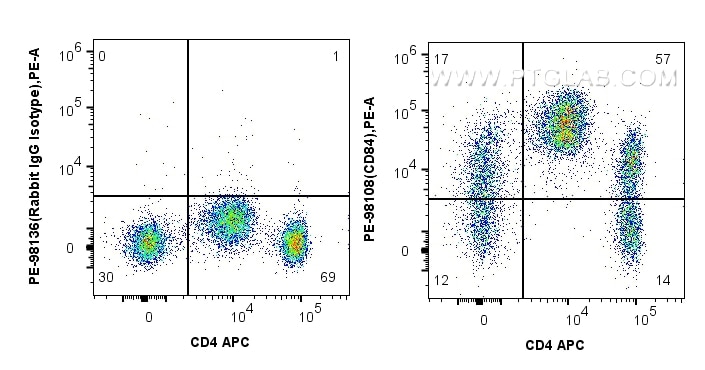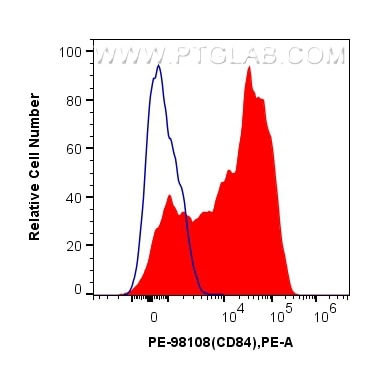Anticorps Recombinant de lapin anti-CD84
CD84 Recombinant Antibody for FC
Hôte / Isotype
Lapin / IgG
Réactivité testée
Humain
Applications
FC
Conjugaison
PE Fluorescent Dye
CloneNo.
241345A3
N° de cat : PE-98108
Synonymes
Galerie de données de validation
Applications testées
| Résultats positifs en cytométrie | CMSP humaines |
Dilution recommandée
| Application | Dilution |
|---|---|
| This reagent has been pre-titrated and tested for flow cytometric analysis. The suggested use of this reagent is 5 ul per 10^6 cells in a 100 µl suspension or 5 ul per 100 µl of whole blood. | |
| Sample-dependent, check data in validation data gallery | |
Informations sur le produit
PE-98108 cible CD84 dans les applications de FC et montre une réactivité avec des échantillons Humain
| Réactivité | Humain |
| Hôte / Isotype | Lapin / IgG |
| Clonalité | Recombinant |
| Type | Anticorps |
| Immunogène | Protéine recombinante |
| Nom complet | CD84 molecule |
| Masse moléculaire calculée | 345 aa, 39 kDa |
| Numéro d’acquisition GenBank | BC020063 |
| Symbole du gène | CD84 |
| Identification du gène (NCBI) | 8832 |
| Conjugaison | PE Fluorescent Dye |
| Excitation/Emission maxima wavelengths | 496 nm, 565 nm / 578 nm |
| Forme | Liquide |
| Méthode de purification | Purification par protéine A |
| Tampon de stockage | PBS with 0.09% sodium azide and 0.5% BSA |
| Conditions de stockage | Store at 2-8°C. Avoid exposure to light. Stable for one year after shipment. |
Informations générales
CD84, also known as SLAMF5, is a member of the CD2 subfamily of the immunoglobulin receptor superfamily (PMID: 9310491). CD84 is a single-chain type-I glycoprotein composed of two extracellular Ig-like domains, a hydrophobic transmembrane region, and a cytoplasmic domain. It is broadly expressed on almost all leukocyte subsets. CD84 functions as a homophilic adhesion molecule, whose signaling can activate or inhibit leukocyte function depending on the cell type and its stage of activation or differentiation (PMID: 30522694).
Protocole
| Product Specific Protocols | |
|---|---|
| FC protocol for PE CD84 antibody PE-98108 | Download protocol |
| Standard Protocols | |
|---|---|
| Click here to view our Standard Protocols |



